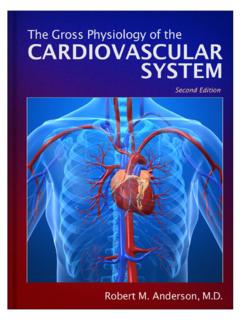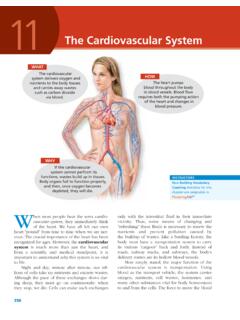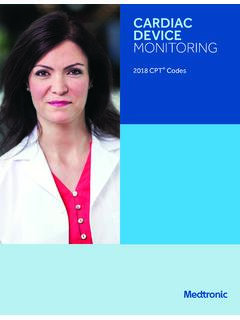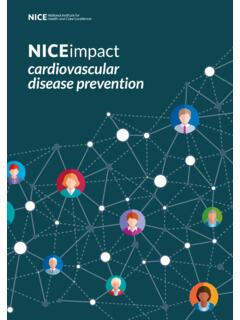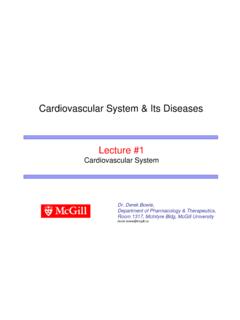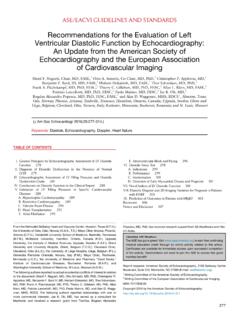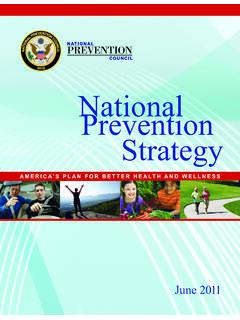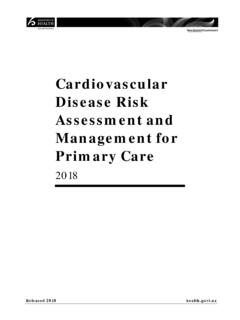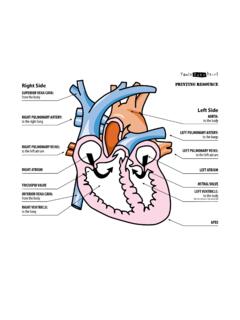Transcription of 16 Cardiovascular Emergencies
1 8. Explain the assessment for patients with Cardiovascular problems. (pp 642 647)9. Explain the relationship between airway management and the patient with cardiac compromise. (pp 643 644) 10. Give the indications and contraindications for the use of aspirin and nitroglycerin. (p 648)11. Recognize that many patients will have had cardiac surgery and may have implanted pacemakers or defibrillators. (pp 653 654)12. Define cardiac arrest. (p 654)13. Compare the difference between the fully automated and the semiautomated defibrillator. (pp 654 655)14. Describe the different types of AEDs.
2 (p 655)15. Explain the use of remote adhesive defibrillator pads. (p 656)16. Recognize that not all patients in cardiac arrest require an electric shock. (p 656) 17. List the indications and contraindications for use of an automated external defibrillator (AED). (pp 656 657)18. Discuss the reasons for early defibrillation. (pp 656 657)19. Explain the circumstances that may result in inappropriate shocks from an AED. (p 657)20. Explain the reason not to touch the patient, such as by delivering CPR, while the AED is analyzing the heart rhythm and delivering shocks. (p 657)21. Describe AED maintenance procedures.
3 (pp 657 659)22. Explain the relationship of age to energy delivery. (p 659)23. Explain the role of medical direction in the use of AEDs. (p 659)24. Discuss the importance of practice and continuing education with the AED. (p 659)25. Explain the need for a case review of each incident in which an AED is used. (p 659)26. List quality improvement goals relating to AEDs. (p 659)27. Discuss the procedures to follow for standard operation of the various types of AEDs. (pp 659 661)28. Describe the emergency medical care for the patient with cardiac arrest. (pp 659 665)29. Describe the components of patient care following AED shocks.
4 (pp 661 663, 665)30. Explain criteria for transport of the patient for advanced life support (ALS) following CPR and defibrillation. (pp 663 664)National EMS Education Standard CompetenciesPathophysiologyApplies fundamental knowledge of the pathophysiology of respiration and perfusion to patient assessment and fundamental knowledge to provide basic emergency care and transportation based on assessment findings for an acutely ill , signs, symptoms, and management of Chest pain (pp 629 665) Cardiac arrest (pp 629 639, 654 665)Anatomy, physiology, pathophysiology, assessment, and management of Acute coronary syndrome (pp 629 639, 642 652) Angina pectoris (pp 629 638, 642 652)
5 Myocardial infarction (pp 629 639, 654 665) Aortic aneurysm/dissection (pp 629 636, 642 652) Thromboembolism (pp 629 637, 642 652) Heart failure (pp 629 636, 640 652) Hypertensive Emergencies (pp 629 636, 642 652)Knowledge Objectives1. Discuss the basic anatomy and physiology of the Cardiovascular system . (pp 629 636)2. Discuss the pathophysiology of the Cardiovascular system . (pp 636 642) 3. Describe the anatomy, physiology, pathophysiology, assessment, and management of thromboembolism. (pp 636 639) 4. Describe the anatomy, physiology, pathophysiology, assessment, and management of angina pectoris.
6 (pp 637 638)5. Describe the anatomy, physiology, pathophysiology, assessment, and management of myocardial infarction. (pp 638 639) 6. Describe the anatomy, signs and symptoms, and management of hypertensive Emergencies . (p 642) 7. Describe the anatomy, physiology, pathophysiology, assessment, and management of aortic aneurysm/dissection. (p 642) Cardiovascular Emergencies Jones & Bartlett 62819/12/15 1:17 PMCopyright 2017 by the American Academy of Orthopaedic Surgeons31. Discuss the importance of coordinating with ALS personnel. (pp 664 665)Skills Objectives1. Describe the steps to take in the assessment of a patient with chest pain or discomfort.
7 (pp 642 647)2. Demonstrate how to provide emergency medical care for a patient with chest pain or discomfort. (pp 647 649)3. Demonstrate the administration of nitroglycerin. (pp 648 649, Skill Drill 16-1)4. Demonstrate how to attach a cardiac monitor to obtain an ECG. (pp 651 652, Skill Drill 16-2)5. Demonstrate how to perform maintenance of an AED. (pp 657 659)6. Demonstrate how to perform CPR. (pp 660 663, Skill Drill 16-3)7. Demonstrate the use of an AED. (pp 660 663, Skill Drill 16-3)are the ProviderYOUPART 1 You and your partner are returning to your station after completing a call when you are dispatched to 1152 Blanco Road for a 60-year-old woman with chest pain.
8 Dispatch advises you that the patient s son, who called 9-1-1, stated that she has a history of heart problems. You proceed to the scene, which is approximately 5 minutes away. The time is 0942 hours, traffic is light, the weather is clear, and the temperature is 80 F (27 C). 1. What is the function of the heart? 2. What does the heart require to function effectively? 3. What should you include in your primary assessment of a patient with cardiac problems?IntroductionThe American Heart Association reports that car-diovascular disease claimed 786,641 lives in the United States in 2011. This is of all deaths, or approximately 1 of every 3 deaths.
9 Although this is a decline from previous years, heart disease has been the leading killer of Americans since is important for EMS providers to under-stand that many deaths caused by Cardiovascular disease occur because of problems that may have been avoided by people living more healthful life-styles and by access to improved medical technol-ogy. We can help to reduce the number of deaths with better public awareness, early access to medi-cal care, increased numbers of laypeople trained in cardiopulmonary resuscitation (CPR), increased use of evolving technology in dispatch and car-diac arrest response, public access to defibrillation devices, the recognition of the need for advanced life support (ALS) services and use of cardiac spe-cialty centers when they are chapter begins with a brief description of the heart and how it works.
10 It then discusses the relationship between chest pain or discom-fort and ischemic heart disease. It explains how to recognize and treat acute myocardial infarction (classic heart attack) and its complications sud-den death, cardiogenic shock, and congestive heart failure (CHF). The use of nitroglycerin and aspirin are described. The last part of the chapter is devoted to the use and maintenance of the auto-mated external defibrillator (AED).Anatomy and PhysiologyThe heart is a relatively simple organ with a simple job. It has to pump blood to supply oxygen- enriched red blood cells to the tissues of the body.










